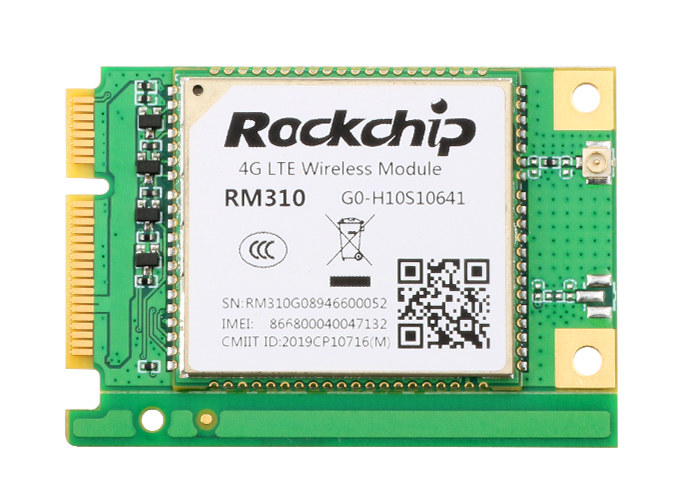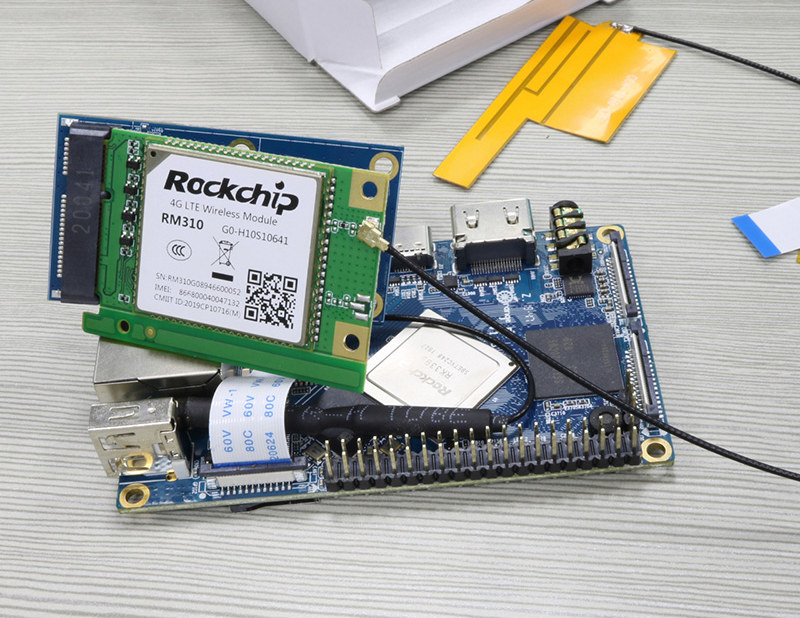Orange Pi 4 SBC is one of the most cost-effective Rockchip RK3399 SBC’s, as it sells for as low as $50 with 4GB RAM, Gigabit Ethernet, WiFi, and Bluetooth, HDMI 2.0 output, etc..
The board also comes with a 24-pin PCIe connector that’s not of much use on its own, so the company introduced a $4 PCIe adapter board providing access to a standard mPCIe socket and a SIM card slot so you could install your own. 4G mini PCIe cards can easily cost around $50 or more, but Shenzhen Xunlong Software has now launched its own 4G LTE mini PCIe card based on Rockchip RM310 module and sold for $16 on Aliexpress, excluding shipping.

- Frequency bands
- LTE-FDD – B1, B3, B5, B8
- LTE-TDD – B38, B39, B40, B41
- WCDMA – B1, B5, B8
- GSM – 850, 900, 1800, and 1900 MHz
- Data rates
- 4G LTE – 150 Mbps DL, 50 Mbps UL
- 3G WCDMA – 42 Mbps DL, 5.76 Mbps UL
- GSM / EDGE – 86.6 Kbps DL and UL
- Bandwidth – 1.4, 3, 5, 10, 15, 20 MHz
- Antenna – DL MIMO with Rx diversity support
- Host Interface – mPCIE socket with USB 2.0 signals
- Supply Voltage – 3.3V to 4.3V (typ. 3.8V)
- Temperature Range – -40 to +85°C
- Dimensions
- RM310 module – 32 x 29 x 2.6mm
- mPCIe card – ~51 x 36 mm (estimated)
Remember you’ll need the PCIe adapter board as well to connect the mini PCIe card. Also, make sure to check the frequency bands are supported in your country/operator using sites such as Frequency Check. The back of the board has silkscreen reading “Rockchip RM310MINIPCIE_V01 2019-07-30GX”, so it might just be a product out of Rockchip instead of a card designed by Shenzhen Xunlong Software. But at this point, I can’t find any other RM310 cards.
Sometimes hardware is launched without software support, but RM310 LTE module support was enabled in Rockchip Linux in March 2020, so hopefully, it’s working well out of the box as long as you run a recent kernel. That also means it should work with any Rockchip RK3399 board or product with a compatible mini PCIe socket. Note that the card may be slightly out of specs mechanically speaking, as mPCIe cards should not be larger than 30 x 51 x 6mm in size.

Jean-Luc started CNX Software in 2010 as a part-time endeavor, before quitting his job as a software engineering manager, and starting to write daily news, and reviews full time later in 2011.
Support CNX Software! Donate via cryptocurrencies, become a Patron on Patreon, or purchase goods on Amazon or Aliexpress





